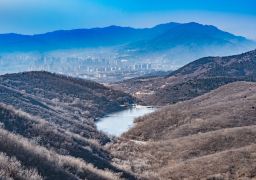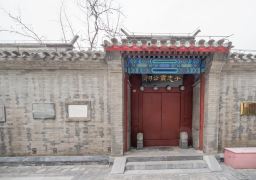The pagoda is located at the southern end of Haiyin Pool. It is a five-story square pagoda with a height of 18 meters. It has a double-layer pedestal and a three-story tower body. There is a platform but no eaves. It is entirely made of beautiful stones from Taihu Lake. The pagoda was rebuilt by Monk Fuzhong in the Yuantong period of the Yuan Dynasty with funds raised. It received financial support from the prince Xuanrang and other feudal princes in Jiangnan. A prince’s pagoda courtyard was also built beside the pagoda. In 1919, Master Yinguang and abbots Liaoyu and Liaoqing invited layman Chen Xingliang to raise donations for repair, forming the current shape. The upper three floors are carved with niches and statues of Buddhas on all four sides. The shape is unique and the charm is ancient and elegant. Especially the small statues of the Thirty-Two Appearances of Guanyin on the third floor are mild and solemn in expression, giving people a sense of kindness and dignity. Its unique style of the precious casket seal is rare in the country. The background of the Buddha statues is the eighteen arhats. Each arhat has a different expression and is lifelike. There are stone railings on each floor’s stone platform. The ends of the stone railing pillars are engraved with patterns such as guardian gods, lions and lotuses. The base platform of the bottom layer of the stone pagoda is relatively wide. The four corners of the top layer are decorated with banana leaf mountain flowers. Under the railings around are carved four faucet heads, with open mouths spouting water. In rainy days, water overflows from the faucet mouths, like a dragon salivating. In the early morning, when the sun rises over the sea, standing in the pagoda courtyard and listening to the melodious bell sound from Puji Temple and the surging tide sound of Baibu Sand Beach. The two sounds echo each other, stirring the heart and making people feel refreshed. Therefore, it has the beautiful name of ‘hearing the bell of the pagoda’. There are also many historical sites and inscriptions in the pagoda courtyard. When Kang Youwei came to Mount Putuo, he inscribed the four characters ‘Number One of Sea and Mountain’ on the rockery stone in the pagoda courtyard. In the pagoda, the ‘Records of the Hidden Teeth under the Prince’s Pagoda on Mount Putuo’ written by Fu Guangzhai, the censor of Liaocheng in the 17th year of Wanli in the Ming Dynasty (1589), and written by Yu Jinyang from Yuyao was also found.
The specific business status and opening hours are subject to the opening situation on that day.
Duobao Pagoda Courtyard
The pagoda is located at the southern end of Haiyin Pool. It is a five-story square pagoda with a he[...]









